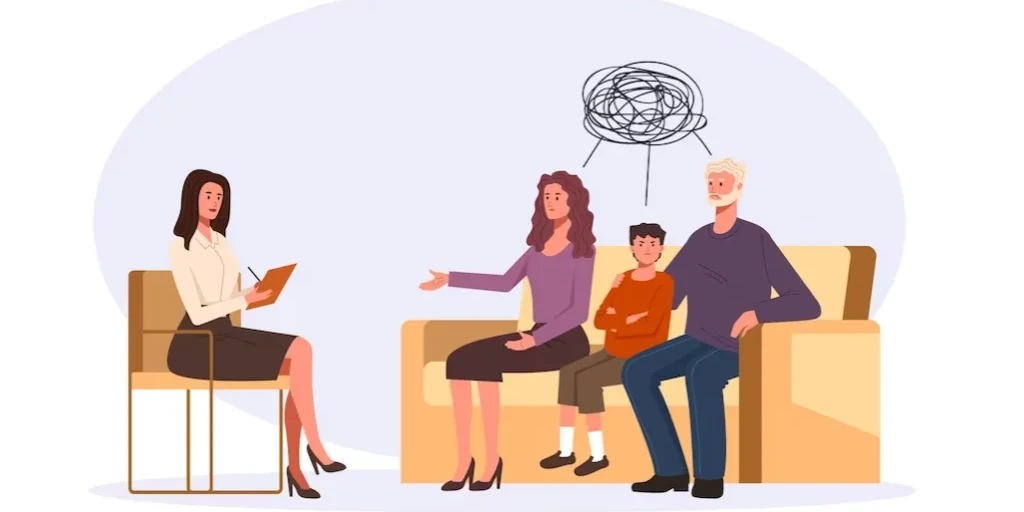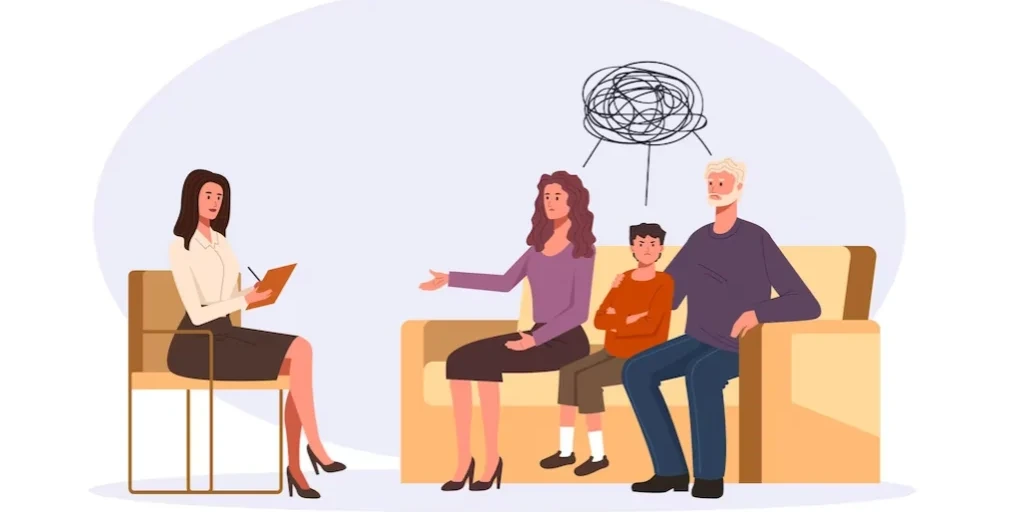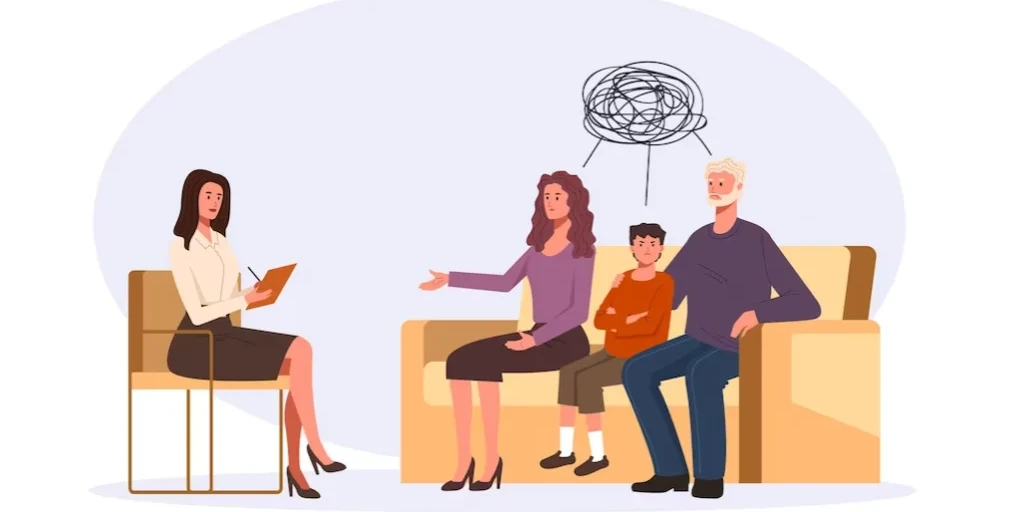24/7 Helpline:
(866) 899-111424/7 Helpline:
(866) 899-1114
Learn more about Eating Disorder Treatment centers in Alamo
Eating Disorder Treatment in Other Cities

Other Insurance Options

Aetna

Lucent

Holman Group

Humana

MHNNet Behavioral Health

Magellan Health

Optum

ComPsych

WellCare Health Plans

Access to Recovery (ATR) Voucher

Kaiser Permanente

Amerigroup

Providence

EmblemHealth

Ceridian

Magellan

United Health Care

State Farm

Sutter

Multiplan

Bridges of Hope
Bridges of Hope is a long-term residential Recovery Center with five locations in the State of Georg...




Sojourne Discovery Center
Sojourne Discovery Center is a private rehab located in Richmond, California. Sojourne Discovery Cen...

Community Health for Asian Americans
Community Health for Asian Americans is a private rehab located in Richmond, California. Community H...

Ujima Family Recovery Services – Women’s Recovery Center
Ujima Family Recovery Services – Women’s Recovery Center is a non-profit rehab located in San Pablo,...

REACH Project
The REACH Project was founded in 1983 under contract with the City of Antioch, California. This drug...

Portia Bell Behavioral Health
Portia Bell Behavioral Health is a private rehab located in Pittsburg, California. Portia Bell Behav...

Impulse Treatment Center
Impulse Treatment Center is a private rehab located in Walnut Creek, California. Impulse Treatment C...

BAART Programs
BAART Programs is an outpatient clinic who provides methadone treatment and substance use counseling...

BAART Programs
BAART Programs is an outpatient clinic who provides methadone treatment and substance use counseling...

Ujima Family Recovery Services
Ujima Family Recovery Services is a non-profit rehab located in Martinez, California. Ujima Family R...

Discovery House
Discovery House is a part of Contra Costa Health Services, and functions as an alcohol and drug reha...

Bi Bett Corp – DAWN Center
Bi Bett Corp - DAWN Center is a private rehab located in Pittsburg, CA. Bi Bett Corp - DAWN Center s...

Bi Bett Corp – East County Community Women’s Center
Bi Bett Corp - East County Community Women's Center is a private rehab located in Pittsburg, CA. Bi ...

Ujima Family Recovery Services – Outpatient Treatment
Ujima Family Recovery Services – Outpatient Treatment is a private rehab located in Richmond, Califo...

Contra Costa County – Alcohol and Other Drugs Services
Contra Costa County - Alcohol and Other Drugs Services provides substance abuse treatment and preven...

Bright Heart Health
Bright Heart Health is a virtual recovery service that uses evidence-based practices to help men and...

Discovery Mood & Anxiety Program – Brentwood
Discovery Mood & Anxiety Program – Brentwood is a private rehab located in Brentwood, California. Di...

Ujima Family Recovery Services – La Casa Ujima
Ujima Family Recovery Services – La Casa Ujima is a private rehab located in Martinez, California. U...

A&A Health Services San Pablo
A&A Health Services is a private boutique drug and alcohol rehabilitation center in San Pablo, Calif...

Kaiser Permanente – Mental Health
Kaiser Permanente – Mental Health is a private rehab located in Antioch, California. Kaiser Permanen...

Diablo Valley Drug and Alcohol Services
Diablo Valley Drug and Alcohol Services offers outpatient services for individuals with alcohol and/...

Wernle Youth and Family Treatment Center
Wernle Youth and Family Treatment Center is a private rehab located in Richmond, IN. Wernle Youth an...

Centerstone of Indiana – English Manor
Centerstone of Indiana - English Manor is a dual diagnosis drug and alcohol rehab, serving adults in...

Centerstone – Samuel Gaar Resource Center
Centerstone – Samuel Gaar Resource Center is a private rehab located in Richmond, Indiana. Centersto...

Centerstone Community Support
Centerstone Community Support is a private rehab located in Richmond, Indiana. Centerstone Community...

Centerstone
Centerstone is a private rehab located in Richmond, Indiana. Centerstone specializes in the treatmen...

Richmond Treatment Center
Richmond Treatment Center is a private rehab located in Richmond, Indiana. Richmond Treatment Center...

Crawford County Mental Health Center
Crawford County Mental Health Center is a public rehab located in Pittsburg, Kansas. Crawford County...

DCCCA – Pittsburg
DCCCA – Pittsburg is a private rehab located in Pittsburg, Kansas. DCCCA – Pittsburg specializes in ...

Liberty Place Recovery Center for Women
Liberty Place Recovery Center for Women is a drug and alcohol addiction treatment center in Richmond...

Ethan Health
Ethan Health is a CARF-accredited drug and alcohol addiction treatment center in Richmond, KY for me...

Sacred Heart Rehabilitation Center
Sacred Heart provides behavioral healthcare services to individuals with mental health disorders, su...

Macomb Family Services
Macomb Family Services is dedicated to provide outpatient mental health and substance abuse treatmen...

Tri County Mental Health Services
Tri County Mental Health Services provides nationally recognized behavioral health services that inc...

Outreach – Outpatient Services
Outreach - Outpatient Services is a non-profit organization offering an outpatient treatment program...

Charles Post Addiction Center – Inpatient
Charles Post Addiction Center - Inpatient is a public rehab located in Brentwood, NY. Charles Post A...

Outreach House II
Outreach House II is a non-profit organization offering a residential treatment program that provide...

Phoenix House – Pilgrim Center
Phoenix House - Brentwood Mental Health Outpatient and Community Residence is a non-profit rehab loc...

Outreach Recovery Center at Pilgrim Center
Outreach Recovery Center at Pilgrim State is a non-profit organization offering a residential treatm...

Outreach Development Corporation
Outreach Development Corporation is a non-profit rehab located in Brentwood, New York. Outreach Deve...

JourneyPure Nashville Alcohol and Drug Rehab Brentwood
JourneyPure Nashville Alcohol and Drug Rehab Brentwood is a private rehab located in Brentwood, Tenn...

Cumberland Heights
Cumberland Heights - Crossroads Boulevard is a 12-step based outpatient alcohol & drug rehab program...

Recovery Unplugged – Nashville
Recovery Unplugged – Nashville is a private rehab located in Brentwood, Tennessee. Recovery Unplugge...

Foundations Recovery Network
Foundations San Diego is a distinctive outpatient center located in the hub of the Hillcrest metropo...

Changes Westpark Springs
Changes Westpark Springs provide partial day programs that address a wide range of mental health cha...

My Next Step – IOP Program
My Next Step - IOP Program is a rehab facility located in Amarillo, TX. My Next Step - IOP Program s...

The CARITAS Healing Place
The CARITAS Healing Place is a non-profit rehab located in Richmond, Virginia. The CARITAS Healing P...

The CARITAS Healing Place for Men
The CARITAS Healing Place for Men provides addiction treatment services for adults in Richmond, Virg...

Richmond Private Methadone Clinic
Richmond Private Methadone Clinic is a state licensed dual-diagnosis drug and alcohol addiction trea...

Counseling Services
Counseling Services is a private rehab located in Richmond, Virginia. Counseling Services specialize...

McShin Foundation
McShin Foundation is a recovery community organization that offers drug and alcohol addiction treatm...
Rubicon – Outpatient Services
Rubicon – Outpatient Services is a private rehab located in Richmond, Virginia. Rubicon – Outpatient...

AppleGate Recovery
AppleGate Recovery is a private rehab located in Richmond, Virginia. AppleGate Recovery specializes ...

Henrico Area Mental Health – Richmond Medical Park
Henrico Area Mental Health – Richmond Medical Park is a public rehab located in Richmond, Virginia. ...

New Life for Youth – The Mercy House
The Mercy House at New Life For Youth is a faith based alcohol and drug addiction recovery center in...

Family Counseling Center for Recovery – Radford
Located in Richmond, Virginia, The Family Counseling Center for Recovery (FCCR) Radford facility is ...

Edgewood Group Family Services
Edgewood Group Family Services is a private rehab located in Richmond, Virginia. Edgewood Group Fami...

New Life for Youth – Main Office
New Life for Youth - Main Office is a rehab facility located in Richmond, VA. New Life for Adults an...

Family Counseling Center for Recovery
Family Counseling Center for Recovery is a private rehab located in Richmond, Virginia. Family Couns...

Richmond Behavioral Health Authority
Richmond Behavioral Health Authority is an organization dedicated to provide mental health and subst...

New Season – Richmond Treatment Center
New Season - Richmond Treatment Center is a private rehab located in Richmond, VA. New Season - Rich...

The Coleman Institute
The Coleman Institute stands as an accredited detox center in Richmond, VA for adults struggling wit...

Archstone Counseling & Treatment
Archstone Counseling & Treatment is a comprehensive addiction treatment center in Richmond, VA. The ...

SAARA of Virginia
SAARA of Virginia is a grassroots recovery community organization that supports addiction prevention...

Dominion Youth Services
Dominion Youth Services is a private rehab located in Richmond, Virginia. Dominion Youth Services he...

Summit Hill Wellness
Summit Hill Wellness provides online treatment programs for alcohol & substance abuse, gambling prob...

Spero Health – Richmond (VA)
Spero Health – Richmond (VA) is a private rehab located in Richmond, Virginia. Spero Health – Richmo...

Broad Highway Recovery
Broad Highway Recovery is a nationwide addiction intervention, recovery monitoring, and consulting c...































































Ujima Family Recovery Services – Intensive Day Treatment
Ujima Family Recovery Services – Intensive Day Treatment is a private rehab located in Pittsburg, Ca...

Anka Behavioral Health
Anka Behavioral Health is a private rehab located in Antioch, California. Anka Behavioral Health spe...

AA – Alcoholics Anonymous
AA – Alcoholics Anonymous is a non-profit rehab located in Pittsburg, California. AA – Alcoholics An...

AA – Alcoholics Anonymous
AA – Alcoholics Anonymous is a non-profit rehab located in Antioch, California. AA – Alcoholics Anon...

Anka Behavioral Health
Anka Behavioral Health is a private rehab located in San Pablo, CA. Anka Behavioral Health specializ...

Alano Club
Alano Club is a non-profit rehab located in Martinez, California. Alano Club specializes in the trea...

REACH Project
REACH Project is a private rehab located in Brentwood, California. REACH Project specializes in the ...

Early Childhood Mental Health Program
Early Childhood Mental Health Program is a non profit rehab located in Richmond, CA. Early Childhood...

J Cole Recovery – Cole House
J Cole Recovery – Cole House is a private rehab located in Antioch, California. J Cole Recovery – Co...

Kaiser Permanente – Chemical Dependency
Kaiser Permanente–Chemical Dependency, in Walnut Creek, California, provides comprehensive addiction...

Familias Unidas Counseling Center
Familias Unidas Counseling Center is a private rehab located in Richmond, California. Familias Unida...

Four Corners Project
Four Corners Project is a private rehab located in El Sobrante, California. Four Corners Project spe...

Anka Behavioral Health – Nevin House
Anka Behavioral Health – Nevin House is a private rehab located in Richmond, California. Anka Behavi...

AA – Alcoholics Anonymous
AA – Alcoholics Anonymous is a non-profit rehab located in Walnut Creek, California. AA – Alcoholics...

Anka Behavioral Health
Anka Behavioral Health is a private rehab located in Pleasant Hill, California. Anka Behavioral Heal...

Discovery Mood & Anxiety Program – Eden Plains Road
Discovery Mood & Anxiety Program – Eden Plains Road is a private rehab located in Brentwood, Califor...

Adult Specialist
Adult Specialist is a private rehab located in Walnut Creek, California. Adult Specialist specialize...

AA – Alcoholics Anonymous – Sobrante Avenue
Alcoholics Anonymous (AA) - Sobrante Avenue is an international fellowship of men and women who have...

Gracer Behavioral Health Services
Gracer Behavioral Health Services offers outpatient and intensive outpatient treatment for individua...

AA – Alcoholics Anonymous
AA – Alcoholics Anonymous is a non-profit rehab located in Byron, Georgia. AA – Alcoholics Anonymous...

Antioch Recovery Club
Antioch Recovery Club is a non-profit rehab located in Antioch, Illinois. Antioch Recovery Club spec...

Meridian Health Services – Adults
Meridian Health Services in Richmond, Virginia, provides adults with alcohol and drug rehabilitation...

Centerstone – Serenity House
Centerstone – Serenity House is a private rehab located in Richmond, Indiana. Centerstone – Serenity...

Centerstone – Pierson House
Centerstone – Pierson House is a private rehab located in Richmond, Indiana. Centerstone – Pierson H...

The Hope House
The Hope House is a non-profit organization located in Richmond, IN. The Hope House specializes in t...

Centerstone – Kinsey Transitional Living
Centerstone – Kinsey Transitional Living is a private rehab located in Richmond, Indiana. Centerston...

Bluegrass – Madison County
Bluegrass - Madison County - Gibson Lane is located in Richmond, Kentucky. Bluegrass - Madison Count...

The Ridge Behavioral Health System
The Ridge Behavioral Health System - Gibson Lane is located in Richmond, Kentucky. The Ridge Behavio...

Spero Health – Richmond (KY)
Spero Health – Richmond (KY) is a private rehab located in Richmond, Kentucky. Spero Health – Richmo...

Mid Missouri Counseling
Mid Missouri Counseling is a private rehab located in Richmond, Missouri. Mid Missouri Counseling sp...

AA – Alcoholics Anonymous
AA – Alcoholics Anonymous is a non-profit rehab located in Richmond, Missouri. AA – Alcoholics Anony...

Central State MHC
Central State MHC provides substance abuse treatment in an outpatient setting for people in Jackson,...

Charles K. Post Addiction Treatment Center
Charles K. Post Addiction Treatment Center is a state-operated intensive inpatient treatment program...

Central Nassau Counseling – Pathways to Recovery
Central Nassau Counseling – Pathways to Recovery is a private rehab located in Brentwood, New York. ...

Sagamore Children’s Psychiatric Center
Sagamore Children’s Psychiatric Center is a drug and alcohol rehab located in Brentwood, NY. They pr...

Family Advantage
Family Advantage is a private rehab located in Pleasant Hill, North Carolina. Family Advantage speci...

FitRx
FitRx is a private rehab located in Brentwood, Tennessee. FitRx specializes in the treatment of dual...

Michael E. DeBakey VA Medical Center – Richmond VA Outpatient Clinic
Michael E. DeBakey VA Medical Center is a public clinic located in Richmond, Texas. Michael E. DeBak...

Drug and Alcohol Services
Drug and Alcohol Services is a private rehab located in Richmond, Virginia. Drug and Alcohol Service...

Brothers Keepers Ministry
Brothers Keepers Ministry is a private rehab located in Richmond, Virginia. Brothers Keepers Ministr...

Clinical Alternatives – Outpatient
Clinical Alternatives – Outpatient is a private rehab located in Richmond, Virginia. Clinical Altern...

Cigna Healthcare – Mental Health and Substance Abuse
Cigna Healthcare – Mental Health and Substance Abuse is a private rehab located in Richmond, Virgini...

Wise Enterprise
Wise Enterprise is a private rehab located in Richmond, Virginia. Wise Enterprise specializes in the...

Blair Rehabilitation Services
Blair Rehabilitation Services is a private rehab located in Richmond, Virginia. Blair Rehabilitation...

Impact Youth Services
Impact Youth Services is a counseling clinic located in Richmond, VA. Impact Youth Services speciali...

Cumberland Community Counseling
Cumberland Community Counseling is a private rehab located in Richmond, Virginia. Cumberland Communi...

Recovery Center of Richmond
Recovery Center of Richmond is a private rehab located in Richmond, Virginia. Recovery Center of Ric...

Colonial Management Group
Colonial Management Group is a private rehab located in Richmond, Virginia. Colonial Management Grou...

Mental Health Community Support Services – The Center for Child and Family
Mental Health Community Support Services – The Center for Child and Family is a private rehab locate...

Al – Anon and Al – Ateen Public Information Service
Al – Anon and Al – Ateen Public Information Service is a non-profit rehab located in Richmond, Virgi...

Faith and Family Advocates
Faith and Family Advocates is a private rehab located in Richmond, Virginia. Faith and Family Advoca...

River City Comprehensive Counseling Services
River City - Comprehensive Counseling Services is a private rehab located in Richmond, VA. River Cit...

Full Circle Ministries
Full Circle Ministries is a private rehab located in Richmond, Virginia. Full Circle Ministries spec...
Rubicon – Women’s Treatment Community
Rubicon Women's Treatment Community is a private alcohol and drug addiction treatment center, in Ric...

Richmond Behavioral Health Authority (RBHA) – Men’s Treatment Center Building
Richmond Behavioral Health Authority (RBHA) – Men’s Treatment Center Building is a drug and alcohol ...

All Care Family Services
All Care Family Services is a private rehab located in Richmond, Virginia. All Care Family Services ...

AA – Alcoholics Anonymous – North Madison Street
AA – Alcoholics Anonymous – North Madison Street is a non-profit rehab located in Richmond, Virginia...

Medical Rehabilitation Consultants
Medical Rehabilitation Consultants is a private rehab located in Richmond, VA. Medical Rehabilitatio...

Family Insight
Family Insight is a private rehab located in Richmond, Virginia. Family Insight specializes in the t...

Family Care Outpatient
Family Care Outpatient is a private rehab located in Richmond, Virginia. Family Care Outpatient spec...

Next Step Recovery House
Next Step Recovery House is a private rehab located in Richmond, Virginia. Next Step Recovery House ...

New Season – Southside Treatment Center
Southside Treatment Center, located in Richmond, Virginia, is a dedicated facility under New Season,...

Offender Aid and Restoration
Offender Aid and Restoration is a private rehab located in Richmond, Virginia. Offender Aid and Rest...

The Virginia Center for Addiction Medicine
The Virginia Center for Addiction Medicine, in Richmond, Virginia, is an outpatient drug and alcohol...

Pathways to Life
Pathways to Life offers outpatient services for children and adults who are struggling with mental h...

Richmond Outpatient – Recovery
Richmond Outpatient – Recovery is a private rehab located in Richmond, Virginia. Richmond Outpatient...

Bicycle Health – Virginia
Bicycle Health - Virginia is an online Medication Assisted Treatment Program. Bicycle Health - Virgi...

New Life For Youth
New Life For Youth is a private rehab located in Richmond, Virginia. New Life For Youth specializes ...

Landmark Recovery of Richmond
Landmark Recovery of Richmond is a private rehab located in Richmond, Virginia. Landmark Recovery of...














































































































































































